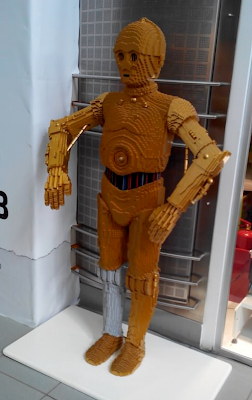Farpoint Station
Hello Troops,
I enjoyed the epic thunderstorm that rumbled through Utah County this afternoon. I was working at my desk in the London Room at Renaissance Academy when I noticed my room grow suddenly dark. I'd planned on putting in a few catch up hours, but staying until night was seriously going above and beyond the call of duty. I looked out my second floor window. What I saw rolling across the valley took me back a step. It looked like the apocalypse was upon us. A boiling mass of black clouds had the school in its sights.
The clouds seemed to be racing ahead of a solid wall of water. The wind rattled my window. The clouds swirled above. A rare Utah tornado suddenly dropping from that angry storm cell wouldn't have surprised me. Had it happened, I would have faced a tough decision. Stay in the school or seek shelter in my Lincoln Battlestar parked in the parking lot. I believe the Battlestar would have won out in the end. Luckily, it was a choice I didn't have to make.
Mr. W.
The New Odyssey II is Taking Shape at the Christa McAuliffe Space Education Center in Pleasant Grove
The Odyssey II is well on its way to becoming the newest simulator in the fleet of ships using my method of totally immersive simulation. Currently the fleet consists of the Phoenix, Magellan, Galileo (all at the CMSEC), Endeavor, Challenger, Atlantis, and Columbia (all at the Discovery Space Center). The Starship Leo is under construction at Lake View Charter School. The Odyssey II is under construction at the CMSEC and Farpoint's Voyager II will be built at Renaissance Academy (my new space center).
 |
| The Odyssey Bridge. The circle platform is the Captain's Station. This is looking back from the front of the bridge. |
 |
| The back of the Odyssey II with the wheelchair ramp visible |
 |
| Looking toward the front of the Odyssey II from the back right stations which sit agains the Control Room wall. |
 |
| Standing at the front of the ship looking back. |
Space and Science News

(From Quarks to Quasars)
Today, I want to talk about what it would be like to spend a day on Venus. As one of Earth’s closest neighbors, it seems only polite that we stop by for a friendly visit every now and then. However, Venus seems to be the black sheep of the solar system. Everyone goes on and on about the glory of Saturn’s rings, the amazing chill of Pluto’s icy craters, and the eminent need to establish a colony on the dusty surface of Mars. But where are the voices lauding the beauty of the Venusian volcanoes, extolling the wonder of the atmospheric lightning bursts, and crying out for the colonization of the Evening Star? Where are the champions of Earth’s twin? Read More
How the Human Face Might Look in 100,000 Years
From Forbes
We’ve come along way looks-wise from our homo sapien ancestors. Between 800,000 and 200,000 years ago, for instance, rapid changes in Earth climate coincided with a tripling in the size of the human brain and skull, leading to a flattening of the face. But how might the physiological features of human beings change in the future, especially as new, wearable technology like Google Glass change the way we use our bodies and faces? Artist and researcher Nickolay Lamm has partnered with a computational geneticist to research and illustrate what we might look like 20,000 years in the future, as well as 60,000 years and 100,000 years out. Read More
New Movie Trailer for Gravity
This is the movie that James Cameron called “the best space film ever done."
Thinnest Dwelling
The world's thinnest dwelling Keret House
by Jakub Szczesny, designed between two existing buildings measuring 92
centimeters in its narrowest point and 152 centimeters in its widest
point, prototype located in Warsaw, Poland.
Keret House is a home of an author, a creator who will use the space
revived by the architect. Etgar Keret will live in the House, invite
guests to his study. All of these will give new meanings to the space.
The no-place will be restored for the city and for the citizens.
Via: designboom.com
The Imaginarium
Making the ordinary, Extraordinary
 |
| How grateful we should be for the blessing of living in this land |
 |
| Real imagination at work here! |
 |
| I've suffered from this for years. There, I've finally admitted it. |
 |
| To my students, "Don't even try it." |
 |
| Very touching |
 |
| This kid's got it right |
 |
| Why you stay in school |
 |
| They said to buy a lock. Hummmm. Epic Fail |
 |
| An imaginative way to fix a fence |
 |
| Portable razor. Creativity: A |
 |
| Imagination: Fail |
Lego Star War's Characters
 |
| Beautiful living room |
 |
| Putting on your own sprinkles |
 |
| Our want ad for Farpoint Station here at Renaissance |

























































































